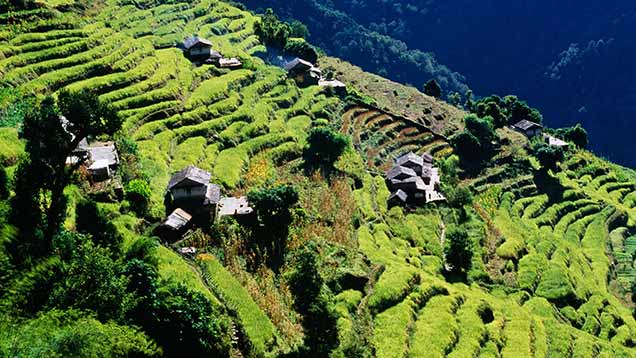Earthquake-hit Nepalese farmers race to plant crops
 Terraces in Nepal before the earthquake ©Rex
Terraces in Nepal before the earthquake ©Rex Farmers hit by the Nepal earthquake face a race against time to plant crops, says the United Nations Food and Agriculture Organisation.
It has called for $8m to help disaster-struck farmers plant rice crops for the coming season.
See also: Nepal earthquake farm fund launched
Villages in Nepal’s most vulnerable agricultural areas were among the worst hit by the 7.8 magnitude earthquake on Saturday (25 April).
Nepalese farmers now face a battle to recover lost agricultural inputs and resume preparations for the imminent rice sowing season, said the UN FAO.
The impact of the recent major earthquake on food security and agricultural livelihoods was expected to be “very high”, warned the FAO.
FAO representative Somsak Pipoppinyo said: “There is a critical window of opportunity to help crop producers plant in time to have a rice harvest this year and regain their self-sufficiency.
“At the same time, we need to do all we can to preserve vital livestock assets which provide affected families with much needed income and nutrition.”
Farmers who missed the planting season, expected to start late May, would be unable to harvest rice – the country’s staple food – again until late 2016.
This, together with likely losses of food stocks and wheat and maize harvests, would severely limit food supplies and incomes in the South Asian country.
Some two-thirds of people in Nepal rely on agriculture for their livelihood, the FAO said.
The earthquake – the country’s biggest in 80 years – shook Nepal, killing thousands while limiting access to food and leaving some 3.5 million in need of food assistance.
Million of people across the country’s western and central regions are affected by the disaster, including its largest cities, Kathmandu and Pokhara.
But some of the country’s most vulnerable agricultural areas, particularly the villages in mountain and hilly regions, also bore the brunt.
Although damage to the agriculture sector has not yet been assessed, affected families have likely lost livestock, crops, food stocks and valuable agricultural inputs.
At the same time, the disaster has destroyed markets and infrastructure, including roads and crucial irrigation and drainage canals.
As a result, internal trade, including the movement of emergency assistance, is severely constrained.
Before the earthquake hit, the FAO estimated Nepal’s wheat production in 2015 at 1.8m tonnes – some 5% below last year’s record harvest.
But it said crop damage and farmer’s inability to harvest in earthquake-affected areas were likely to change this forecast.
In addition, it said disruption of planting operations for rice and maize may severely reduce the planted area for these crops in the most affected areas.
In all, the FAO said it would support 20,000 of the most vulnerable farming households to protect and rebuild their livelihoods.
Timely agricultural interventions were essential to increase the resilience of affected farming families and greatly reduce the time and cost of recovery, it added.
